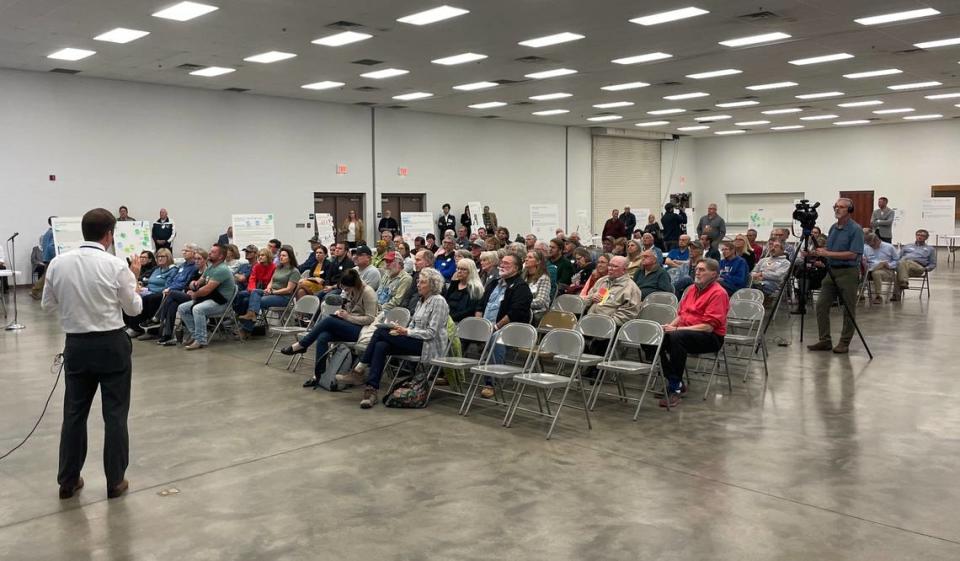Commercial solar projects in Sedgwick County? Residents weigh in at town hall meeting
Days after Harvey County moved to ban commercial solar farms, Sedgwick County residents got a chance to weigh in on how such projects should be regulated.
Sedgwick County has had a temporary moratorium on solar applications since September at the direction of the County Commission.
Scott Wadle, director of the Wichita-Sedgwick County Metropolitan Area Planning Department, emphasized at the outset of Thursday’s town hall meeting that any additional restrictions imposed would not apply to people who use solar panels to generate electricity for their own homes or businesses.
“We’re really talking about utility and commercial,” he said.
The county has no large-scale solar farms now, but one company — Chicago-based Invenergy — has approached some rural Sedgwick County property owners about using their land as part of a project it’s calling the Chisholm Trail Solar Energy Center.
Ivenergy did not submit an application to the planning department before the county enacted its moratorium, which will stay in effect until March, when staff are expected to offer any proposed regulation changes for a commission vote.

“I believe that solar can be a valuable part of our family’s farming operation,” said Megan Albert, who was approached by Invenergy and plans to participate in the project.
“I would encourage the county to refrain from over-regulation. That’s something that trumps private property rights in the name of appeasing those who say ‘Not in my backyard.’”
Kent Rowe, an Air Force veteran and member of the Kansas Sierra Club, noted that Kansas is ranked 46th in the country for solar panel installations by the Solar Energy Industries Association.
“I saw the transition of the U.S. Army and Air Force bases to renewable energies,” Rowe said. “These are secure energies — a lot more secure than centralized systems.”
Not everybody who spoke up was in favor of embracing solar power.
Leroy Bosch, who lives in the rural Maize-Colwitch area, said commercial solar projects should be banned outright until the county can conduct an independent study on the risks they could pose to the water supply. He’s worried about shallow groundwater being contaminated by zinc-coated pylons.
“Much is unknown about long-term toxicity of solar panels and supportive structures. They have lead, cadmium, zinc,” Bosch said. “Douglas County is currently reviewing [their solar zoning requirements] because of potential zinc contamination. Land use, population and water were the reasons Harvey County has rejected it. All of that would hold to Sedgwick County but in a greater proportion.”
Marianne Harmon said she wants to make sure solar panels used in large-scale projects are responsibly sourced.
“Not only the panels themselves but the materials that are used to build these panels,” she said. “They need to be not using slave labor, not hurting the environment irresponsibly.”
Stan Bergkamp, who has taught physics at Maize High for the last 30 years, led the drive to install 720 solar panels in a field next to the school to help power the Maize Career Academy.
“Is any source of electricity perfect? No,” Bergkamp said.
But he believes communities that invest in alternatives to fossil fuels are the ones that will be the most appealing to future generations.
“In my experience, kids are very willing and want to embrace this idea of renewable energy.”
Existing requirements
Sedgwick County last tightened restrictions on commercial solar developments in 2019, when the commission also banned wind farms over concerns that they could interfere with airport and flight operations.
As it stands, solar panel configurations may not exceed 35 feet in height and structures must be set back from the project boundary and rights-of-way by at least 40 feet. An 8-foot perimeter fence must also be erected.
Under existing rules, when a commercial solar application is submitted to the planning department, they must provide detailed information on the technology they plan to use, as well as a glare-hazard analysis. Filing an application triggers a mandatory notification process for nearby property owners.
If the proposed development is located within the urban growth area of any city, that city’s planning commission would also be given a chance to review the conditional use application and make a recommendation.
Before the governing body — either County Commission or city council — rules on whether to allow it, there is a 14-day window for nearby property owners to file a protest with the clerk.
The planning department recorded feedback from the town hall that will be reviewed by the advanced plans committee and shared with officials before any changes in solar regulation are finalized next year. The county also has an online survey for residents to provide additional comments.

